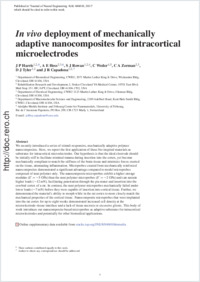In vivo deployment of mechanically adaptive nanocomposites for intracortical microelectrodes
- Harris, J. P. Department of Biomedical Engineering, CWRU, Cleveland, USA - Rehabilitation Research and Development, L Stokes Cleveland VA Medical Center, Cleveland, USA
- Hess, Andreas E. Rehabilitation Research and Development, L Stokes Cleveland VA Medical Center, Cleveland, USA - Department of Electrical Engineering, CWRU, Cleveland, USA
- Rowan, Stuart J. Department of Biomedical Engineering, CWRU, Cleveland, USA - Rehabilitation Research and Development, L Stokes Cleveland VA Medical Center, Cleveland, USA - Department of Macromolecular Science and Engineering, CWRU, Cleveland, USA
- Weder, Christoph Department of Macromolecular Science and Engineering, CWRU, Cleveland, USA - Adolphe Merkle Institute and Fribourg Center for Nanomaterials, University of Fribourg, Switzerland
- Zorman, C. A. Rehabilitation Research and Development, L Stokes Cleveland VA Medical Center, Cleveland, USA - Department of Electrical Engineering, CWRU, Cleveland, USA
- Tyler, D. J. Department of Biomedical Engineering, CWRU, Cleveland, USA - Rehabilitation Research and Development, L Stokes Cleveland VA Medical Center, Cleveland, USA
- Capadona, Jeffrey R. Department of Biomedical Engineering, CWRU, Cleveland, USA - Rehabilitation Research and Development, L Stokes Cleveland VA Medical Center, Cleveland, USA
-
08.06.2011
Published in:
- Journal of Neural Engineering. - 2011, vol. 8, no. 4, p. 046010
English
We recently introduced a series of stimuli-responsive, mechanically adaptive polymer nanocomposites. Here, we report the first application of these bio-inspired materials as substrates for intracortical microelectrodes. Our hypothesis is that the ideal electrode should be initially stiff to facilitate minimal trauma during insertion into the cortex, yet become mechanically compliant to match the stiffness of the brain tissue and minimize forces exerted on the tissue, attenuating inflammation. Microprobes created from mechanically reinforced nanocomposites demonstrated a significant advantage compared to model microprobes composed of neat polymer only. The nanocomposite microprobes exhibit a higher storage modulus (E' = ~5 GPa) than the neat polymer microprobes (E' = ~2 GPa) and can sustain higher loads (~12 mN), facilitating penetration through the pia mater and insertion into the cerebral cortex of a rat. In contrast, the neat polymer microprobes mechanically failed under lower loads (~7 mN) before they were capable of insertion into cortical tissue. Further, we demonstrated the material's ability to morph while in the rat cortex to more closely match the mechanical properties of the cortical tissue. Nanocomposite microprobes that were implanted into the rat cortex for up to eight weeks demonstrated increased cell density at the microelectrode–tissue interface and a lack of tissue necrosis or excessive gliosis. This body of work introduces our nanocomposite-based microprobes as adaptive substrates for intracortical microelectrodes and potentially for other biomedical applications.
- Faculty
- Faculté des sciences et de médecine
- Department
- AMI - Chimie des polymères et matériaux
- Language
-
- English
- Classification
- Physics
- License
- License undefined
- Identifiers
-
- RERO DOC 27394
- DOI 10.1088/1741-2560/8/4/046010
- Persistent URL
- https://folia.unifr.ch/unifr/documents/302050
Statistics
Document views: 66
File downloads:
- wed_idm.pdf: 190
